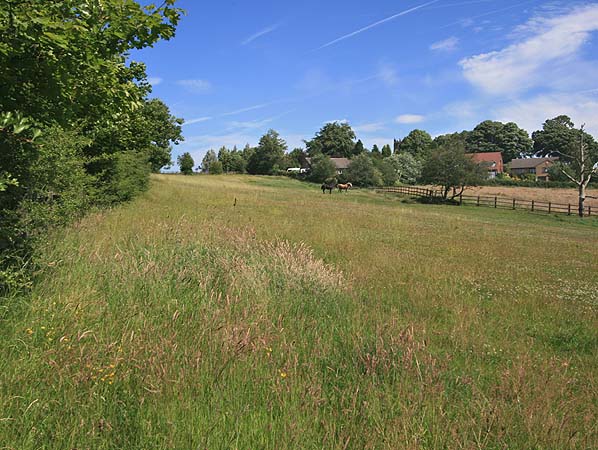
Station Name: TIBSHELF TOWN
Click here for Tibshelf Town Station Gallery 2:
c1959-1963 - June 2008
town.old4a.jpg) Having descended the gradient to Tibshelf Town, this freight train is probably stationary and awaiting clearance of the signal just out of the picture to the right. The locomotive carries a Class H headcode, telling us the train is a 'through freight not fitted with the automatic brake' and would be restricted to a maximum speed of 35mph. The locomotive is Class O1 2-8-0 No.63784. Class O1, of which there were ultimately 58 examples, was numerically lumped together with the much larger, in respect of quantity, Class O4 and its many sub-variants of which there were eight albeit not all at the same time. The history of the type is extremely complicated so what follows is brief. The type began life in 1911, designed by Robinson for Great Central Railway coal traffic and became famous during WWI as the ROD 2-8-0; Classes 8M and 8K respectively. In original form they bore little resemblance to what eventually became Class O1 as seen here. The Thompson B1 4-6-0 appeared from 1942 and a number of the O4's were given Diagram 100A boilers as fitted to the B1 during 1944. These became Class O4/8. Further examples were fitted with the 100A boiler but also given new cylinders, Walschaerts valve gear and a few other minor alterations, especially to the cab, and these examples became LNER/BR Class O1 of which seven were so-rebuilt during BR days. No.63784 began life in 1918, being new from North British, w/n 21858, in May of that year entering service with the War Department as ROD No.1881. No record of her being sent abroad has been found. In 1924 she became LNER No.6507 and in that company's 1946 renumbering scheme No.2784. She survived with British Railways until August 1963, being scrapped at Doncaster in, it is thought, early 1964. Prior to rebuilding into the form seen here, she had been a member of Class O4/3. During the 1950s she had spent periods at Annesley, March (for coal trains to Temple Mills) and Staveley sheds from which latter she was withdrawn. Unfortunately her shedplate is unreabable but appears to begin with a '4' and if so will be 41H, Staveley. Given this, we can date the photograph to the December 1959 - August 1963 period. In Britain the breed became extinct in April 1966 with the withdrawal of the final surviving members of Class O4/8. One, No.63601, has survived into preservation in Britain. She is a Class O4/1 and as such is visually very similar to the original design. As with the WWII 'Austerity' 2-8-0s, a number of the O4s ended up abroad and of these the final survivors in commercial service bowed out in Australia in 1973. Of the thirteen RODs which ended up in Australia, three are known to still exist.
Photo
from Jim Lake collection
town.old7.jpg) Sometime around 1960 an unidentified 2-8-0 restarts from a signal check at Tibshelf Town. The locomotive has a Diagram 100A boiler, which tells as she is either an O4/8 or and O1. However, among the haze of this rather poor image is what appears to be outside steampipes and Walschaerts valve gear, which means she is a Class O1. The train is completely obscured by steam from the cylinder drain cocks and although the locomotive appears to be carrying the headcode for a local passenger train it is most likely to be freight. The goods sidings are seen on the right.
Tibshelf Town down platform looking north from a passing southbound train in October 1961. A totem sign can be seen beneath the canopy.
Photo
from Jim Lake collection
Tibshelf Town station in March 1963. By this date the up station building had been demolished a replaced by a waiting shelter. St John The Baptist's Church overlooks the station on the right.
Copyright photo from Stations UK
Tibshelf Town station looking north some time in the early 1960s after the up side building has been replaced by a waiting shelter.
Photo
from John Mann collection
Evelyn Woodward stands on the Tibshelf Town station forecourt looking north mid 1960s.
Photo
by Albert Woodward received from Paul Vaughan
town4.jpg)
Looking south from High Street bridge towards Tibshelf Town station in April 1969. Both platforms are intact but the edge stones have been removed from the up platform which is now very degraded. The goods yard was beyond the platform on the up side.
Photo
by John Mann
Looking north at Tibshelf station in April 1969. The steep station approach road can be seen on
the far left.
Photo
by John Mann
Remains of the Tibshelf Town goods office in April 1969.
Photo
by John Mann

The site of Tibshelf Town station looking north in June 2008
Photo
by Nick Catford
The 'Station Gallop' running through the site of the goods yard to the south of the station in May 2008
Photo by Nick Catford
| Last
updated:
Friday, 26-May-2017 08:55:24 CEST
|
© 1998-2017 Disused Stations |
|

